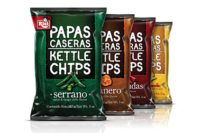Making The Best Of A Royal Mess
By Dan Malovany
Less than a week after disaster struck in October 2004, Snak King restarted production of its pork rind line, which was only slightly affected by the partial collapse of its roof, subsequent flooding by its fire suppression system, and a fire in one of its two environmental emissions devices.
In just a few short weeks, employees cleaned up and relocated the company’s tortilla chip line and began cranking out the signature products sold under its El Sabroso and Jensen’s Orchard brands, as well as its private label offerings.
About 18 months later, production today at the 177,000-sq.-ft. facility reflects the old adage that necessity is truly the mother of invention. As Snak King continues its $30 million remodeling, reorganization and upgrading of the plant, it’s not surprising that operations are anything but normal. How could they be? The collapsed roof knocked out some 40,000 sq. ft. of production space.
Despite the tight quarters, the City of Industry, Calif., plant is running at full tilt, cranking out a wide variety of snacks that are sold across the country. In addition to the sheer determination to get production up and running as soon as possible, Snak King relied on its employees’ improvisational thinking, even if it meant jerry-rigging lines and shoehorning systems into almost every nook and cranny.
“The design today doesn’t make much sense,” acknowledges Ron Jones, Snak King’s president and COO. “We had to put things where they could fit. Sometimes, that meant fitting equipment into different angles and into any other space possible.”
To relocate the tortilla chip line, for instance, Snak King cut its nut roasting area in half, squeezed in its four scale/baggers and placed a temporary wall between the two production areas to eliminate any allergen cross-contamination.
The tortilla chip line produces upwards of 3,000 lb. an hour in a space that would normally house an operation half of its size in capacity. Production runs in a giant U-shape around the edge of the room, with packaging systems flowing into the open area in the middle.
Specifically, after mixing corn flour, the batch is sheeted out, roll cut into triangles and fried. After traveling through a three-tier cooler, the tortilla chips flow along a vibrating conveyor into a seasoner/salter station. From there, bucket conveyors take the products up to one of four new automatic scalers that exactly measure out products to form/fill/seal (f/f/s) or to other packaging machines. The high-speed packaging systems can produce up to 140 single-serve size bags a minute.
Pork rinds and other meat snacks are produced in another walled-off area for inspection by the U.S. Department of Agriculture. The line produces about 1,200 lb. of product per hour. After frying and salting in one room, the snacks are conveyed to a second room, where three seasoners, scales and f/f/s baggers produce 35 to 80 packages a minute, depending on their sizes.
Yet another area houses a caramel corn line that produces 1,800 lb. an hour and a popcorn operation with a 1,000-lb. capacity. In addition, Snak King wedged in two new versatile extruder lines that bake or fry 1,200 to 1,400 lb. of cheese curls, cheese puffs, hot fries, angel puffs and other corn products. Although it’s not the best of situations, every inch of space is being used to its maximum potential.
The next trick for the improv artists will be to keep production running smoothly as it upgrades the facility. If all goes well, the refurbished plant should be fully up and running some time this summer, says Barry Levin, chairman and CEO.
Except for pork rinds and roasted nuts, which must be produced in separate areas, most production will run in a straight line from one end of the plant to another. In the main production area, there will be two tortilla chip lines producing 8,000 lb. per hour and four extruded snack lines, in addition to existing popcorn and caramel corn lines. The two additional extruded lines will boost combined capacity of those snacks to 2,500 lb. an hour.
Some operations, such as its caramel corn line, will be refurbished with new controls, piping and platform supports, Jones says. New packaging systems also are being installed to provide greater flexibility and to serve a wide variety of distribution channels.
In all, Jones estimates that about 80% of Snak King’s equipment will be new and provide much-needed capacity, improved efficiencies and potentially greater versatility to produce a variety of new products.
Already, many of the systems have been delivered and are sitting at a nearby warehouse, waiting to be installed. To prepare for their installation, Snak King has built a new wooden roof where the previous one collapsed, but the company still needs to install fire suppression systems, new floors, new utilities and repaint the walls.
The goal, say Levin, is to transform the facility into a showcase operation in the salted snack industry.
“When you come back, it’s not going to look the same,” he explains. “It won’t look like [the same plant] at all.” SF&WB
Editor’s Note: Stay tuned for part two. Snack Food & Wholesale Bakery plans to revisit Snak King’s plant when the refurbishing is completed later this year.





